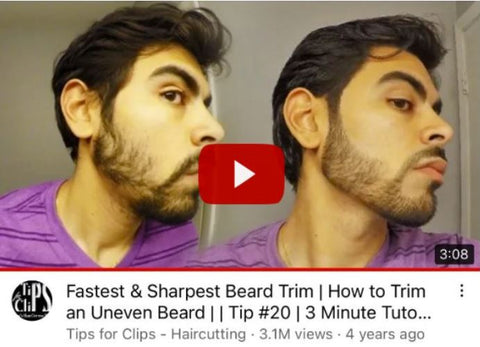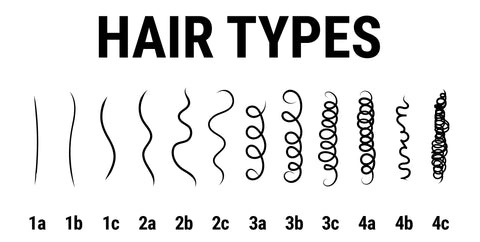
Straightening These 4 Beard Types Can Be a Mistake
6 min read
- You may not want to straighten your beard if it's patchy, curly, coarse, or dense. That’s because it may not look great, or it won’t stay straight for long. Some types require prolonged heat exposure that can dry out hair and risk damage.
- Be patient. Sometimes your beard isn’t problematic. It just needs to grow out. Straightening out a longer/fuller beard can have better results.
- If all else fails, embracing your beard’s natural state may be your best option. That doesn’t mean leaving it untidy! Upkeep of your beard includes trimming, shaping, and nourishing. Also, consider a professional consultation to make this process smoother.
Beards are a symbol of masculinity and wisdom. And they can even be a work of art.
But only if you care for your beard the right way.
An unkempt man mane communicates sloppiness. And we can’t let you go out into the world that way. You need to be looking dapper my dude.
Guys are noticing that the longer their beard gets, a simple wash and oil routine doesn’t cut it. Beards relent to their wild nature even after a few strokes from a beard brush. This is why beard straightening techniques are growing in popularity.
But it isn’t always a great idea to straighten your beard.
Some beards won’t stay put, and others don’t look their best when tame.
Today, we’ll cover four types of beards that thrive when they’re wild.
Beard Types You May Not Want to Straighten
There are many reasons to keep your beard in its natural state. From safety to style, your beard's thickness, texture, and growth pattern influence whether you’ll want to straighten it or not.
Patchy Beard

A patchy beard deserves some love.
But maybe not from your beard straightener.
Straightening a patchy beard can highlight uneven growth and thinness. It also has an unnatural appearance.
We advise you to let it grow. New growth can cover up patchy spots. You’ll need to brush or comb in the direction that covers patchiness.
Once you’re happy with your beard’s length, trim it to tidy up. The aim is to accentuate your best facial features and minimize your weak ones. It’ll help draw attention away from your patchy spots.
Check out this YouTube video from Tips for Clips showing how our Clearshaper is used to trim a patchy beard.

As with anything, context is key. Some patchy beards may benefit from using a heated brush at an angle to cover up patchy spots. Experiment and see what works best for you!
Curly Beard

Type 4 hair is one of the most common types among men of African descent.
Taking care of a type 4 beard can be tricky. But it looks damn good when done properly. The lush volume and natural curls are a work of art.
Type 4 hair is described as kinky and curly with a wiry texture. It comes in three sub-types. 4a, 4b, and 4c.

Type 4a retains moisture the easiest, meaning you don’t have to worry about heat drying up your beard. It also doesn’t shrink as much, so showing off your beard length is easier.
Type 4b is at risk of breakage when not cared for properly. Take caution when straightening this hair type. It’s easier to straighten and manage than type 4c, but if it doesn’t react well you may not want to straighten it.
Type 4c is usually the hardest to wash and style. It also gets tangled and knotted easily. Trying to straighten this hair type can be a mistake. This is because type 4c hair is the most fragile and dry. We recommend using a blow dryer and brush over a heated straightener for this type.
Some guys with curly beards can get away with using a heated brush, some can’t. It all depends on the thickness of your hair, the density of your curls, and how well your hair retains moisture. Type 4a and 4b feature looser curls, while type 4c has tighter, more densely packed curls. Type 4a also holds moisture better than the others.

|
Tip: You may need to use a higher heat setting such as 430° for type 4 hair. Always use a lower setting first and slowly work your way up. Our upgraded Aberlite Pro features a new maximum temperature of 430° (increased from 400°) among other improvements. |

So, what’s the solution for a curly beard?
We recommend using a beard relaxer cream to tame your curly mane.
Beard relaxer cream straightens your beard. But it isn’t a permanent solution. Your new growth will come in curly. So be sure to reapply the cream as needed.
|
Pro Tip: For everyday maintenance, consider using a wood or aluminum pick comb. Cheaper materials such as plastic can bend easily and be a nuisance. |

Type 3 hair also falls into the curly hair category. It’s less prone to dryness and breakage. Using a heated brush or any other straightening method is fine — just remember to nourish your hair.
Coarse Beard

The struggle with a coarse beard has always been lasting straightness. There are two issues here. Dryness and brittleness.
No matter what you do, your beard won’t stay in place for more than a few hours. Here’s how to resolve each issue.
How to tackle dryness: You need to go back to the basics. Start by using a specialized beard shampoo. Regular shampoo is harsh and strips your beard of too much moisture. Beard shampoo is gentle enough and gets the job done.
Moisturize with beard oil after your wash and at least once per day. This combats the wiry nature of your strands and gives your beard much-needed moisture.
Condition. Condition. Condition.
How to fix the brittleness: Water is alkalized and it’ll make your beard coarser. To soften your beard, you need to use a beard conditioner. A softer beard will stay tidy for longer, and it's better for your skin.
Note that this is a gradual process. It may take a few weeks until your beard is accustomed to your new beard care routine.
Now that we have the two main challenges taken care of, let’s look at additional tips on how to straighten a coarse beard.
Straightening a coarse beard is only a mistake if you do it wrong.
You can straighten using a heated brush or a blow dryer. Regardless of the method, keep the quality of your device at the forefront of this operation. Heat damage is serious stuff.
For heated brushes, apply a temperature around 300° to 375° F and under 290° F for thinner hair. Also, look for a quick heat-up time and consistent heat output in the features of your straightener. This will make for a quick straightening session which minimizes heat exposure to your beard.
We also recommend using a heat protectant spray. Typically, this would be part of the “bells and whistles” section. But if you have a coarse beard, this can become an essential product.
For coarse beard owners: We can’t stress the importance of going above and beyond in your beard care. You’ll have to nail the basics and then some.
Dense Beard

Much like the coarse beard, there’s a chance of excessive heat exposure with a dense beard. This may be due to using a heated straightening technique for too long.
Why? Because you can’t get the darn thing straight of course!
Dense beards are tricky because you’ll find it hard to achieve uniform straightness. This is a fancy way of saying it’ll be straight in some areas and scraggly in others. It’ll take longer to straighten, just like a coarse beard.
A dense beard’s best friend is a beard conditioner. This allows the hair to be softer — meaning a smoother straightening session.
Simply apply the conditioner after you wash your beard. Let it sit for a few minutes before rinsing it out.
Pat dry your beard until it's damp, and you’re ready to start straightening.
Straightening Alternatives
If you’ve discovered that your beard doesn’t take well to straightening techniques — here are some alternatives.
• Embrace the flow, bro: Wavy, curly, and dense beards are all Mother Nature’s way of styling your facial hair. It’s not just about looks, but practicality. Your beard protects your skin from the elements and makes you more attractive to a potential mate. Trust Mother Nature!

Final Thoughts
The main drawbacks of straightening a patchy, curly, coarse, or dense beard are as follows:
Coarse and dense beards don’t stay straight for long. Moreover, you may need longer sessions which can risk heat damage.
Curly beards might not straighten completely. And depending on the density of curls, your beard will be left in “half curled, half not” purgatory.
Straightening a patchy beard can highlight thin spots, but it can also cover them.
Instead of seeing your beard as a challenge, work with your natural beard texture.
You can do this by practicing proper grooming techniques. Use a beard wash along with beard oil or butter. Conditioning will soften the hair, allowing for easier straightening and styling. Also, consider a boar’s hair beard brush.
Check out this boar bristle brush from Zeus. The bristles are strong enough to train even the most stubborn beard hairs.
Beard-shaping tools get an honorable mention here too. They come in clutch for managing a patchy beard.
Do you have other challenges with your beard? Let us know by sending us an email at support@aberlite.com. We’ll be glad to help.
